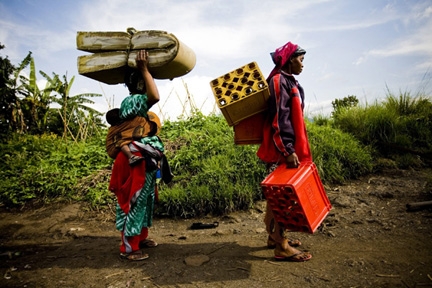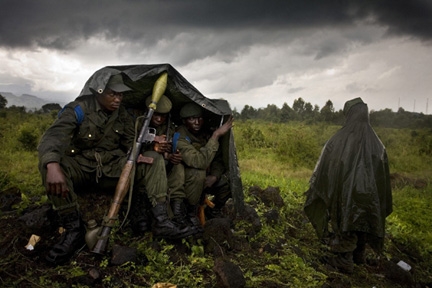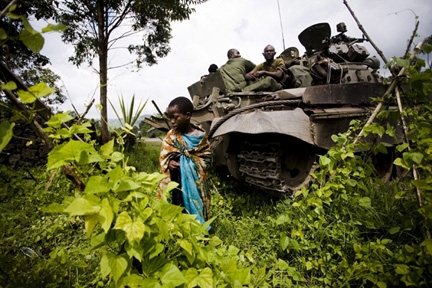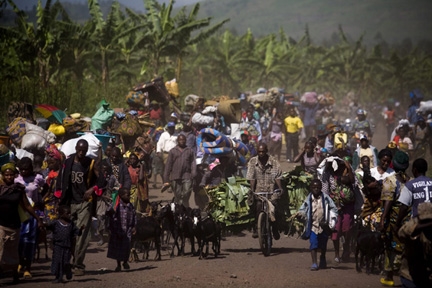Perpignan photojournalism festival
Road to Nowhere
by Aidan O'Donnell
Article published on the 2009-09-02 Latest update 2009-09-07 06:48 TU
Dominic Nahr is a young photojournalist who was born in Switzerland, was raised in Hong Kong and is currently based in Nairobi. It’s only his second visit to Perpignan and this year he’s one of the selected exhibitors. “It’s a big honour for me,” he says “because I’m really new into the game”.
“I just graduated last year from university so for somebody like me to be put up next to some huge names and to have the response that I’m getting…”
The “response” is to his exhibition The Road to Nowhere, images taken towards the end of 2008, during fighting between the army of the Democratic Republic of Congo and the CNDP forces of renegade general, Laurent Nkunda.
Nahr had never travelled to Africa before and picked the east DRC for his first trip.
“Because we were starting from the government side, we’d first cover the government side. Then we see if we can cross and it gets a little tricky and you’re kind of crossing no man’s land to get to the rebel side,” he says.
“The rebels were a bit harder because they were much more organised in terms of media, and allowing or not allowing us to take pictures,” he explains, adding that the Congolese army was more relaxed in terms of letting him photograph what he wanted because they were always busy with advancing, retreating and so on.
“And you could photograph them, they would forget you were there. So with the Congolese army it was a lot easier to get dramatic photographs and spend time with them without being frustrated by the fact that you weren’t allowed to take pictures”.
Nahr explains that the rebels had a media-clearance heirarchy worthy of any bureaucratic 21st century organisation. “You had to get clearance from the top. And it took forever and we’d sit there for three hours in the sun, waiting,” he says.
Dominic Nahr - This is north of Goma, in Rumangabo. It’s a strategic point. It’s where the initial fighting happened between the CNDP and the government soldiers. The CNDP took over a base on the top of a hill and then the government soldiers took it over again so it was a bit of a back and forth.
In the photograph there are two women, one is carrying a mattress and a baby and the other one is carrying empty beer and coke canisters. They’re standing in the middle of the road and this was just in a break in fighting.
There’d been heavy fighting an hour, maybe half an hour before that and we saw a couple of villages return back to get a few things in the lull of fighting and then kind of get out of there again as soon as possible. A lot of the homes were looted so I’m even surprised they found stuff to take back.
It might not even be theirs but I guess they were just getting what they could before the fighting began again.
Dominic Nahr - I felt something for the Congolese soldiers as well because these guys are really hungry. They sleep in the mud. Every day.
They don’t get paid much, they don’t get food and they have to fight and watch their friends die. And they’re kind of crazy too because you put somebody for that long into the bush, with no coverage? And I really wanted to make a picture that felt like it was continuous, this is going to go on for a while.
And I think that’s what they do, they wait a lot, in the rain, in the dirt, with their weapons and with this sky that kind of says ‘there’s more to come’. Which there always is for these soldiers. There’s always more to come.
Dominic Nahr - We see a village girl who actually stayed behind with her family. Left of this picture are homes. So they’re just parked up right on their lawn pretty much.
The girl just walked up to the tank – I don’t know she was giving them something or taking something, I just got there as she moved away from the tank. This was right after the tank brigade of the Congolese government forces had successfully warded off the CNDP. The CNDP didn’t really have any hard artillery but Rwandans were helping them out from the Rwandan side.
The whole picture is wrapped with this kind of greenery, this kind of jungly greenery that so much of east Congo is all about. It’s very wealthy in earth, minerals – everything is green actually in that picture. Except the girl.
Dominic Nahr - We see an entire frame, filled with people coming towards myself, and towards Goma. My back is to Goma.
This is pretty much the junction where people either go into Goma or they continue around Goma to go further past Goma. And this was the day when fighting was coming up as close as it has ever been. And these are the last stragglers, the refugees, that were in-between the government forces and the rebel forces. The rebels were just coming in way closer than ever before.
We even got stuck under some fighting, the advancement was extremely fast. So you have about 40-60,000 people moving towards Goma. It was incredible. It was biblical. I couldn’t explain it, so you just try and make pictures that explain it.









